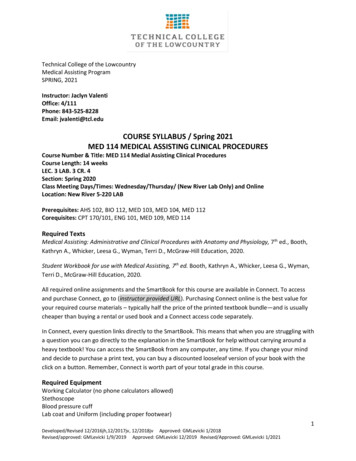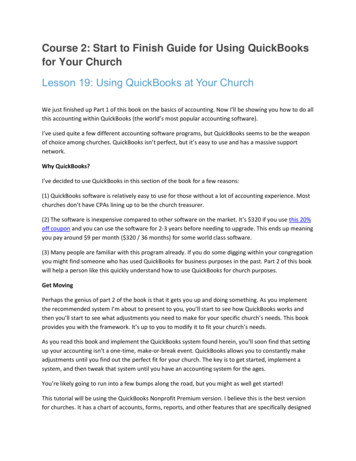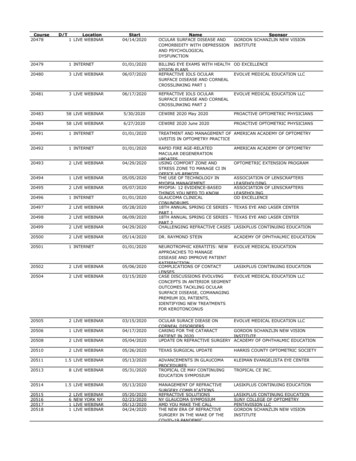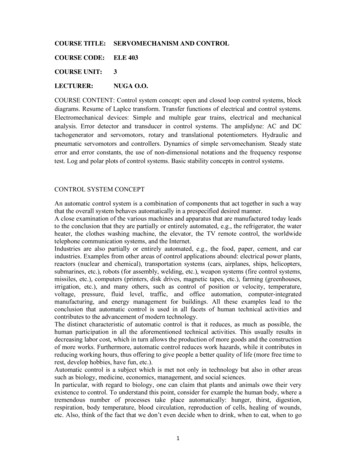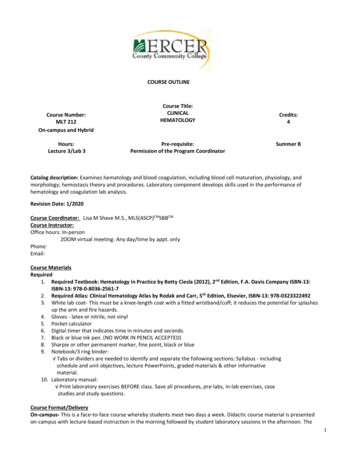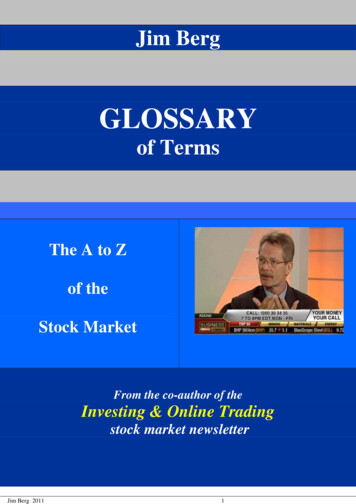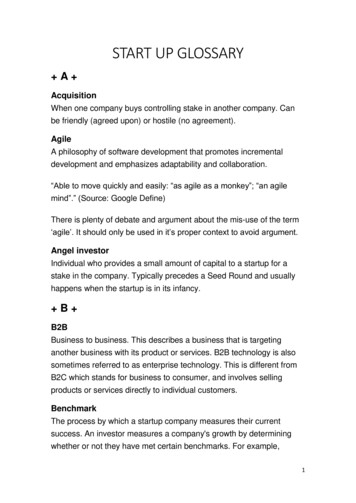
Transcription
START UP GLOSSARY A AcquisitionWhen one company buys controlling stake in another company. Canbe friendly (agreed upon) or hostile (no agreement).AgileA philosophy of software development that promotes incrementaldevelopment and emphasizes adaptability and collaboration.“Able to move quickly and easily: “as agile as a monkey”; “an agilemind”.” (Source: Google Define)There is plenty of debate and argument about the mis-use of the term‘agile’. It should only be used in it’s proper context to avoid argument.Angel investorIndividual who provides a small amount of capital to a startup for astake in the company. Typically precedes a Seed Round and usuallyhappens when the startup is in its infancy. B B2BBusiness to business. This describes a business that is targetinganother business with its product or services. B2B technology is alsosometimes referred to as enterprise technology. This is different fromB2C which stands for business to consumer, and involves sellingproducts or services directly to individual customers.BenchmarkThe process by which a startup company measures their currentsuccess. An investor measures a company's growth by determiningwhether or not they have met certain benchmarks. For example,1
company A has met the benchmark of having X amount of recurringrevenue after 2 years in the market.Board of directorsA group of influential individuals, elected by stockholders, chosen tooversee the affairs of a company. A board typically includes investorsand mentors. Not all startups have a board, but investors typicallyrequire a board seat in exchange for an investment in a company.BootstrappedA company is bootstrapped when it is funded by an entrepreneur'spersonal resources or the company's own revenue. Evolved from thephrase "pulling oneself up by one's bootstraps."Bootstrapping“Bootstrapping or booting refers to a group of metaphors that share acommon meaning: a self-sustaining process that proceeds withoutexternal help.” (Source: Wikipedia)The meaning will vary depending on context. Bootstrapping incomputing and software development, varies slightly to bootstrappingin business. The commonality is the characteristics of ‘selfsustainability’ and creating something that can be ‘grown’.Bootstrap Startup“Bootstrapping involves launching a business on a low budget.Practically this means that you’ll outsource (most likely off-shore) yourdesign and development, you‚’ll rent your servers, you won‚’t have anoffice and you’ll have no salary. Prior to launch, the only expensiveprofessional services which you’ll buy will be your legal advice andaccountancy services. Everything else, you’ll have to pick up yourselfand learn as you go along.” (Source: RWW)An Example of 3 Stages of a Bootstrap (Source: Ash Maurya):1. Ideation (Demo)2. Valley of Death (Sell)3. Growth (Build)Note that a bootstrap and lean startup have differences andbootstrapping does not mean spending any money.2
“Bootstrapping and Lean Startups are quite complementary. Bothcover techniques for building low-burn startups by eliminating wastethrough the maximization of existing resources first before expendingeffort on the acquisition of new or external resources. Whilebootstrapping provides a strategic roadmap for achieving sustainabilitythrough customer funding (i.e. charging customers), lean startupsprovide a more tactical approach to achieving those goals throughvalidated learning.” (Source: Ash Maurya)Bridge loanAlso known as a swing loan. Short-term loan to bridge the gapbetween major financing.Business Plan“A business plan is a written document that describes a business, itsobjectives, its strategies, the market it is in and its financial forecasts. Ithas many functions, from securing external funding to measuringsuccess within your business.” (Source: Business Link)A business plan is a static operational document to how your businesswill run.Business Model“The Business Model Canvas is a strategic management template fordeveloping new or documenting existing business models. It is a visualchart with elements describing a firm’s value proposition, infrastructure,customers, and finances. It assists firms in aligning their activities byillustrating potential trade-offs.” (Source: Wikipedia)A business model is a dynamic document that describes how yourcompany creates, delivers and captures value.The 9 Business Model Canvas Building Blocks (Source: BusinessModel Generation):1. Customer Segments2. Value Propositions3. Channels4. Customer Relationships5. Revenue Streams6. Key Resources7. Key Activities8. Key Partnerships9. Cost Structure3
Burn Rate“The rate at which a new company uses up its venture capital tofinance overhead before generating positive cash flow from operations.In other words, it’s a measure of negative cash flow.”(Source: Investopedia)When your burn rate increases or revenue falls it is typically time tomake decisions on expenses (eg reduce staff).BuyoutA common exit strategy. The purchase of a company's shares thatgives the purchaser controlling interest in the company. C CapitalMonetary assets currently available for use. Entrepreneurs raisecapital to start a company and continue raising capital to grow thecompany.Capital under managementThe amount of capital, or financial assets, that a venture capital firm iscurrently managing and investing.Capped notesRefers to a "cap" placed on investor notes in a round of financing.Entrepreneurs and investors agree to place a cap on the valuation ofthe company where notes turn to equity. This means investors will owna certain percentage of a company relative to that cap when thecompany raises another round of funding. Uncapped rounds aregenerally more favorable to an entrepreneur/startup.Convertible debtThis is when a company borrows money with the intent that the debtaccrued will later be converted to equity in the company at a latervaluation. This allows companies to delay valuation while raisingfunding in it's early stages. This is typically done in the early stages of4
a company's life, when a valuation is more difficult to complete andinvesting carries higher risk.Customer Development Model“The ‘traditional’ way to approaching business is the ProductDevelopment Model. It starts with a product idea followed by months ofbuilding to deliver it to the public.” (Source: Find The Tech Guy)However the Customer Development Model begins by talking toprospective customers and developing something they are interestedin purchasing/using. These concepts are promoted strongly by SteveBlankand Eric Ries who encourage startups to get early and frequentcustomer feedback before developing their products too far (in thewrong direction).The four steps to the model (Source: Find The Tech Guy):1. Customer Discovery2. Customer Validation3. Customer Creation4. Company Building D Debt financingThis is when a company raises money by selling bond, bills, or notes toan investor with the promise that the debt will be repaid with interest. Itis typically performed by late-stage companies.DisruptionAlso known as disruptive innovation. An innovation or technology isdisruptive when it "disrupts" an existing market by doing things suchas: challenging the prices in the market, displacing an old technology,or changing the market audience.“An innovation that helps create a new market and value network, andeventually goes on to disrupt an existing market and value network(over a few years or decades), displacing an earlier technology. Theterm is used in business and technology literature to describeinnovations that improve a product or service in ways that the marketdoes not expect, typically first by designing for a different set of5
consumers in the new market and later by lowering prices in theexisting market.” (Source: Wikipedia)The term ‘disruptive technologies’ was coined by Clayton M.Christensen and articulated in his book The Innovator’s Dilemma.The term ‘disruption’ is now often used by startups to describe anyproduct or idea that may change existing markets or products (plannedor unplanned). However to be used correctly it should link toChristensen’s original theory. The confusion is best explained here.An example is the disruption Wikipedia caused to the Encyclopediamarket.Due diligenceAn analysis an investor makes of all the facts and figures of a potentialinvestment. Can include an investigation of financial records and ameasure of potential ROI. E Elevator Pitch“An elevator pitch is a concise, carefully planned, and well-practiceddescription about your company that your mother should be able tounderstand in the time it would take to ride up an elevator.”(Source:Business Know How)Being able to pitch your idea is crucial for entrepreneurs and valuablein any formal or informal networking situation. It allows you to quicklydescribe your concept to anyone in a short period of time, includingpotential partners or investors.EnterpriseThe term enterprise typically refers to a company or business (i.e. anenterprise tech startup is a company that is building technology forbusinesses).6
Entrepreneur“An entrepreneur is an individual who accepts financial risks andundertakes new financial ventures. The word derives from the French“entre” (to enter) and “prendre” (to take), and in a general senseapplies to any person starting a new project or trying a newopportunity.” (Source:wiseGEEK)Entrepreneur in residence (EIR)A seasoned entrepreneur who is employed by a Venture Capital Firmto help the firm vet potential investments and mentor the firm's portfoliocompanies.Equity“In finance, equity is ownership in any asset after all debts associatedwith that asset are paid off.” (Source: Investopedia)Equity Assets minus LiabilitiesIn terms of startup, it is commonly used to describe a business givingup a percentage of ownership in exchange for cash. An equity investoris then entitled to share in any future profits and/or sale of businessassets (after debts are paid off).ExitThis is how startup founders get rich. It's the method by which aninvestor and/or entrepreneur intends to "exit" their investment in acompany. Commons options are an IPO or buyout from anothercompany. Entrepreneurs and VCs often develop an "exit strategy"while the company is still growing. F Fund of fundsA mutual fund that invests in other mutual funds. G Ground floorA reference to the beginning of a venture, or the earliest point of astartup. Generally considered an advantage to invest at this level.7
I IncubatorAn organization that helps develop early stage companies, usually inexchange for equity in the company. Companies in incubators get helpfor things like building their management teams, strategizing theirgrowth, etc.Intraprenuer“Coined in the 1980s by management consultant Gifford Pinchot,intrapreneurs are used by companies that are in great need of new,innovative ideas. Today, instead of waiting until the company is in abind, most companies try to create an environment where employeesare free to explore ideas. If the idea looks profitable, the person behindit is given an opportunity to become an intrapreneur.”(Source: Investopedia)‘Intrapreneurs’ hold many similar characteristics to ‘Entrepreneurs’ anymay well leave their jobs to pursue a career as an entrepreneur.Companies seek out intrapreneurs to effect change within theirorganisations.IPOInitial public offering. The first time shares of stock in a company areoffered on a securities exchange or to the general public. At this point,a private company turns into a public company (and is no longer astartup). L Lead investorA venture capital firm or individual investor that organizes a specificround of funding for a company. The lead investor usually invests themost capital in that round. Also known as "leading the round."8
LeanAlso referred to as: lean manufacturing, lean enterprise, leanproduction.“The core idea is to maximize customer value while minimizing waste.Simply, lean means creating more value for customers with fewerresources.” (Source: Lean Enterprise Institute)The definitions and usage of ‘lean’ vary depending on context andapplication. The origin of the word in business can be linked back tothe 90’s.“Lean manufacturing is a management philosophy derived mostly fromthe Toyota Production System (TPS)”. (Source: Wikipedia)The key focus is around the reduction of waste whiling focusing ondelivering value to the customer.Lean Startup“Lean startup is a term coined and trade marked by Eric Ries. Hismethod advocates the creation of rapid prototypes designed to testmarket assumptions, and uses customer feedback to evolve themmuch faster than via more traditional product development practices,such as the Waterfall model. It is not uncommon to see Lean Startupsrelease new code to production multiple times a day, often using apractice known as Continuous Deployment.” (Source: Wikipedia)You should note the slight differences between lean and bootstrapping.“Bootstrapping provides a strategic roadmap for achievingsustainability through customer funding (i.e. charging customers), leanstartups provide a more tactical approach to achieving those goalsthrough validated learning.” (Source: Ash Maurya)An Example of 3 Stages of a Lean Startup (Source: Ash Maurya):1. Customer Discover (Problem/Solution Fit)2. Customer Validation (Product/Market Fit)3. Customer Creation (Scale)Note that a bootstrap and lean startup have differences andbootstrapping does not mean spending any money.9
Leveraged buyoutWhen a company is purchased with a strategic combination of equityand borrowed money. The target company's assets or revenue is usedas "leverage" to pay back the borrowed capital.LiquidationThe process of dissolving a company by selling off all of its assets(making them liquid). M Mezzanine financingA form of hybrid capital typically used to fund adolescent and maturecash flow positive companies. It is a form of debt financing, but it alsoincludes embedded equity instruments or options. Companies at thislevel, which are no longer considered startups but have yet to gopublic, are typically referred to as "mezzanine level" companies.MVP Minimum Viable ProductA minimum viable product (MVP) is the "version of a new productwhich allows a team to collect the maximum amount of validatedlearning about customers with the least effort" (similar to a pilotexperiment) N Non Disclosure Agreement (NDA)Non-disclosure agreement. An agreement between two parties toprotect sensitive or confidential information, such as trade secrets,from being shared with outside parties.10
P PivotThe act of a startup quickly changing direction with its businessstrategy. For example, an enterprise server startup pivoting to becomean enterprise cloud company.Portfolio companyA company that a specific Venture Capital firm has invested in isconsidered a "portfolio company" of that firm.Preferred stockA stock that carries a fixed dividend that is to be paid out beforedividends carried by common stock.Proof of conceptA demonstration of the feasibility of a concept or idea that a startup isbased on. Many VCs require proof of concept if you wish to pitch tothem.Pro rata rightsAlso known as supra pro rata rights. Pro rata is from the Latin 'inproportion.' A VC with supra pro rata rights gives him or her the optionof increasing his or her ownership of a company in subsequent roundsof funding. R RecapitalizationA corporate reorganization of a company's capital structure, changingthe mix of equity and debt. A company will usually recapitalize toprepare for an exit, lower taxes, or defend against a takeover.ROIThis is the much-talked-about "return on investment." It's the money aninvestor gets back as a percentage of the money he or she has11
invested in a venture. For example, if a VC invests 2 million for a 20percent share in a company and that company is bought out for 40million, the VC's return is 8 million.RoundStartups raise capital from VC firms in individual rounds, depending onthe stage of the company. The first round is usually a Seed roundfollowed by Series A, B, and C rounds if necessary. In rare casesrounds can go as far as Series F, as was the case with Box.net. S SaaSSoftware as a service. A software product that is hosted remotely,usually over the internet (a.k.a. "in the cloud").SeedThe seed round is the first official round of financing for a startup. Atthis point a company is usually raising funds for proof of conceptand/or to build out a prototype and is referred to as a "seed stage"company.Secondary public offeringWhen a company offers up new stock for sale to the public after anIPO. Often occurs when founders step down or desire to move into alesser role within the company.SectorThe market that a startup companies product or service fits into.Examples include: consumer technology, cleantech, biotech, andenterprise technology. Venture Capitalists tend to have experienceinvesting in specific related sectors and thus tend not to invest outsideof their area of expertise.12
SeriesRefers to the specific round of financing a company is raising. Forexample, company X is raising their Series A round.StageThe stage of development a startup company is in. There is no explicitrule for what defines each stage of a company, but startups tend to becategorized as seed stage, early stage, mid-stage, and late stage.Most VCs firms only invest in companies in one or two stages. Somefirms, however, manage multiple funds geared toward different stagecompanies.StartupA startup company is a company in the early stages of operations.Startups are usually seeking to solve a problem of fill a need, but thereis no hard-and-fast rule for what makes a startup. A company isconsidered a startup until they stop referring to themselves as astartup. T Term sheetA non-binding agreement that outlines the major aspects of aninvestment to be made in a company. A term sheet sets thegroundwork for building out detailed legal documents. V ValuationThe process by which a company's worth or value is determined. Ananalyst will look at capital structure, management team, and revenueor potential revenue, among other things.13
Venture Capital (VC)Money provided by venture capital firms to small, high-risk, startupcompanies with major growth potential.Venture capitalistAn individual investor, working for a venture capital firm, that choosesto invest in specific companies. Venture capitalists typically have afocused market or sector that they know well and invest in.VestingWhen an employee of a company gains rights to stock options andcontributions provided by the employer. The rights typically gain value(vest) over time until they reach their full value after a pre-determinedamount of time. For example, if an employee was offered 200 stockunites over 10 years, 20 units would vest each year. This givesemployees an incentive to perform well and stay with the company fora longer period of tup-and-venture-capital-terms-you-shouldknow/14
Lean Also referred to as: lean manufacturing, lean enterprise, lean production. “The core idea is to maximize customer value while minimizing waste. Simply, lean means creating more value for customers with fewer resources.” (Source: Lean Enterprise Institute) The definitions and usage of ‘




